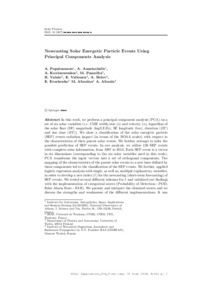Nowcasting Solar Energetic Particle Events Using Principal Component Analysis
Papaioannou A; Anastasiadis A; Kouloumvakos A; Paassilta M; Vainio R; Valtonen E; Belov A; Eroshenko E; Abunina M; Abunin A
Nowcasting Solar Energetic Particle Events Using Principal Component Analysis
Papaioannou A
Anastasiadis A
Kouloumvakos A
Paassilta M
Vainio R
Valtonen E
Belov A
Eroshenko E
Abunina M
Abunin A
SPRINGER
Julkaisun pysyvä osoite on:
https://urn.fi/URN:NBN:fi-fe2021042719504
https://urn.fi/URN:NBN:fi-fe2021042719504
Tiivistelmä
We perform a principal component analysis (PCA) on a set of six solar variables (i.e. width/size () and velocity () of a coronal mass ejection, logarithm of the solar flare (SF) magnitude (), SF longitude (), duration (), and rise time ()). We classify the solar energetic particle (SEP) event radiation impact (in terms of the National Oceanic and Atmospheric Administration scales) with respect to the characteristics of their parent solar events. We further attempt to infer the possible prediction of SEP events. In our analysis, we use 126 SEP events with complete solar information, from 1997 to 2013. Each SEP event is a vector in six dimensions (corresponding to the six solar variables used in this work). The PCA transforms the input vectors into a set of orthogonal components. By mapping the characteristics of the parent solar events, a new base defined by these components led to the classification of the SEP events. We furthermore applied logistic regression analysis with single, as well as multiple explanatory variables, in order to develop a new index () for the nowcasting (short-term forecasting) of SEP events. We tested several different schemes for and validated our findings with the implementation of categorical scores (probability of detection (POD) and false-alarm rate (FAR)). We present and interpret the obtained scores, and discuss the strengths and weaknesses of the different implementations. We show that holds prognosis potential for SEP events. The maximum POD achieved is 77.78% and the relative FAR is 40.96%.
Kokoelmat
- Rinnakkaistallenteet [27094]
